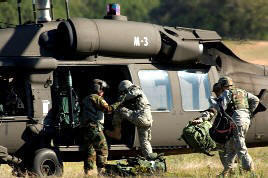- Homepage >
- Organization >
- Aviation
Aviation
U.S. Army
Operational Test Command
91002 Station Avenue, ATTN: TEOT-AV
Fort Hood, Texas 76544-5068
Directorate Mission
On order, the Aviation Test Directorate conducts independent operational testing of Army aviation aircraft and aviation systems to inform acquisition executives on operational issues impacting materiel decisions for our assigned Systems Under Test.
Who We Are
Test Plans Division - Lead planners for all tests; coordinating and synchronizing test efforts, while providing continuity for long-term systems under test.
Test Analysis Division - Analyze system documents to prepare data collection requirements for assigned test plans and report on deliverable test data.
Test Operations Division - Provide subject matter experts and manpower to execute test plans.
What We Do
Test aviation doctrine, training, organization, and equipment systems to ensure they meet Soldiers' needs in an operational environment.
Conduct tests under the most realistic conditions possible to approximate the anticipated aviation environment.
Test new aviation concepts, materiel, and systems to consider their effects on the total force.
Test equipment in theater without negatively impacting tactical missions.
Balance support to the Warfighter with traditional acquisition efforts.
History
Army Aviation operational testing can trace its history to the earliest days of the aeroplane when Lieutenant Benjamin E. Foulois was directed to test a Wright Brothers biplane in 1910. Aviation testing evolved with the "Air Service" as it transitioned to the "Army Air Corps." By the mid-1930s, operational tests were conducted on the "autogiro" and the helicopter in 1941. Various tests were conducted through WWII and the post-war years on the concept of aviation assets organic to maneuver units. The Air Support Service Test Section activated in 1945 evolved at several locations until settling at Camp Rucker, Alabama, in 1954.
The test section became Army Aviation Service Test Division of Board number 1 in 1955 and was later designated the Army Aviation Board the same year. In 1962, the board became part of the Test and Evaluation Command, a major subordinate command of the Army Materiel Command. During this period materiel acquisition was heavily weighted toward hardware development. In July 1976, the office of the Secretary of Defense and the Department of the Army recognized a need for user representation during the acquisition cycle, and as a result, the United States Army Aviation Test Board was divided into two new test organizations: the United States Army Aviation Development Test Activity and the United States Army Aviation Board -- the latter designed to meet operational testing needs.
Formally activated by the Training and Doctorate Command (TRADOC) on 1 July 1976, the Aviation Board was assigned to the United States Army Aviation Center, Fort Rucker, Alabama. In the ensuing years, the Aviation Board family established itself as a valuable member of the testing community, continually meeting the challenges that face Army aviation and taking great pride in the professional execution of its mission.
On 2 October 1988, the establishment of TRADOC's newest major subordinate command, the Test and Experimentation Command (TEXCOM), drew together all of TRADOC's user test and experimentation activities. The Aviation Board became part of this new organization and was subsequently re-designated the TEXCOM Aviation Board. On 8 November 1990, the TEXCOM Aviation Board was re-designated the TEXCOM Aviation Test Directorate. During the month of January 1991, the Aviation Test Directorate moved from Fort Rucker, Alabama, to Fort Hood, Texas.
On 1 October 1999, TEXCOM
officially became the
Operational Test Command (OTC)
under the newly designated Army
Test and Evaluation Command
(ATEC). The OTC family consists
of geographically dispersed
testing entities. Facilities not
only provide crucial support to
TRADOC schools, but also provide
a broad-based quick reaction
capability ready to meet both
programmed and unprogrammed time
sensitive tests and field
experiments.
